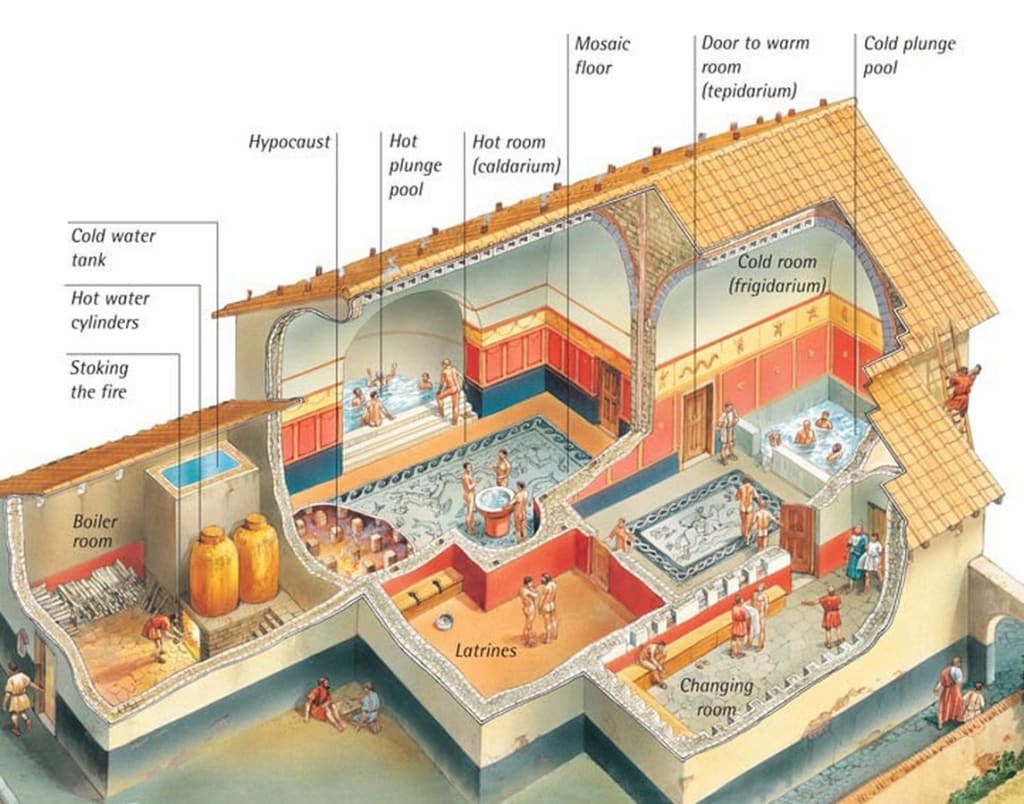
Roman bathhouses, known as thermae, were monumental public structures that played a central role in the social and cultural life of ancient Rome. These sophisticated complexes went beyond mere bathing; they were centers for socializing, exercising, and conducting business. This article explores the origins, architectural design, cultural significance, social impact, technological innovations, and enduring legacy of Roman bathhouses.
Origins and Historical Context
Roman bathhouses trace their origins to the 2nd century BCE, evolving from earlier Greek bathing practices. The Romans adopted and expanded these concepts, integrating them into their urban planning and daily life. By the height of the Roman Empire, bathhouses were ubiquitous in cities and towns across the empire, reflecting the importance of hygiene, leisure, and social interaction in Roman culture.
Architectural Design and Features
Roman bathhouses were architectural masterpieces, showcasing the engineering prowess and aesthetic sensibilities of the Romans:
- Complex Layout: Bathhouses typically included a series of interconnected rooms with different functions, such as the apodyterium (changing room), frigidarium (cold bath), tepidarium (warm bath), caldarium (hot bath), and laconicum (steam room).
- Heating Systems: One of the most remarkable features was the hypocaust system, an underfloor heating mechanism that circulated hot air generated by furnaces (praefurnia) beneath the floors and through the walls, maintaining consistent temperatures in the hot rooms.
- Water Management: Advanced plumbing systems, including aqueducts and lead pipes, ensured a constant supply of fresh water. Sophisticated drainage systems also managed wastewater, showcasing the Romans' expertise in hydraulic engineering.
- Decoration and Amenities: Bathhouses were lavishly decorated with mosaics, frescoes, marble statues, and columns. They also included amenities such as gymnasiums, libraries, gardens, and lecture halls, making them multifunctional centers of activity.
Cultural and Social Significance
The cultural and social impact of Roman bathhouses was profound, influencing various aspects of Roman life:
- Social Hub: Bathhouses were places where people from all social classes could mingle, relax, and socialize. They were venues for conversation, gossip, and networking, reflecting the communal nature of Roman society.
- Health and Hygiene: Regular bathing was considered essential for good health and personal hygiene. Bathhouses also promoted physical fitness through associated gymnasiums and exercise yards.
- Leisure and Recreation: Beyond bathing, bathhouses offered a range of recreational activities, including swimming, ball games, and board games. They were places of relaxation and enjoyment, contributing to the quality of life in Roman cities.
Technological Innovations
Roman bathhouses were at the forefront of technological innovation, particularly in the fields of engineering and architecture:
- Hypocaust System: The hypocaust system represented a significant advancement in heating technology, enabling the Romans to maintain warm indoor environments even in large public buildings.
- Aqueducts and Plumbing: The construction of aqueducts and sophisticated plumbing systems demonstrated the Romans' mastery of water management, ensuring a reliable supply of fresh water and effective wastewater disposal.
- Architectural Design: The design and construction of large, vaulted spaces in bathhouses, such as the frigidarium and caldarium, showcased the Romans' engineering skills and their ability to create durable and aesthetically pleasing structures.
Enduring Legacy and Modern Relevance
The legacy of Roman bathhouses extends into the modern world, influencing contemporary architecture, public health, and social practices:
- Architectural Influence: The architectural principles and engineering techniques developed in Roman bathhouses have influenced the design of modern public buildings, including spas, swimming pools, and sports complexes.
- Cultural Heritage: Many ancient Roman bathhouses, such as those in Bath (England), Pompeii, and Rome, have been preserved as archaeological sites and tourist attractions, providing valuable insights into Roman culture and technology.
- Public Health: The Roman emphasis on hygiene and public bathing has influenced modern public health practices, highlighting the importance of cleanliness and communal facilities for health and well-being.
Conclusion
Roman bathhouses stand as remarkable testaments to the ingenuity, sophistication, and cultural richness of ancient Rome. These architectural marvels were more than just places for bathing; they were vibrant centers of social interaction, leisure, and public life. Through their advanced engineering, luxurious design, and multifunctional use, Roman bathhouses have left an enduring legacy that continues to influence contemporary society. As symbols of Roman civilization's achievements, they remind us of the timeless importance of community, health, and innovation in human history.
About the Creator
Marveline Merab
“History never repeats itself. Man always does.”
― Voltaire
Enjoyed the story? Support the Creator.
Subscribe for free to receive all their stories in your feed. You could also pledge your support or give them a one-off tip, letting them know you appreciate their work.






Comments
There are no comments for this story
Be the first to respond and start the conversation.